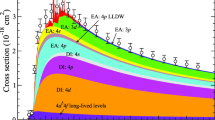Abstract
Present work studies the dynamical properties of the O + O2 collision by the quasi-classical trajectory method on the double many-body expansion potential energy surface. Our study includes both the exchange and dissociation reactions. For different rovibrational levels of O2, the integral cross-sections (ICSs) distributions of both channels as a function of translational energy were obtained in a range of collision energy from 0.1 to 30 eV, and the dissociation rate was calculated in the temperature range of 1000–20 000 K. Appreciable differences are found for the excitation functions between the two channels as expected for the dissociation with no barrier and exchange having a small barrier. The initial collision energy and vibrational excitation both play an enormous role in the ICSs for both channels, while the rotational excitation of the reagent has a weak effect on it. The results show that vibrationally excited states have some contribution to the dissociation rate.









Similar content being viewed by others
REFERENCES
A. L. van Wyngarden, K. A. Mar, K. A. Boering, et al., J. Am. Chem. Soc. 129, 2866 (2007). https://doi.org/10.1021/ja0668163
A. L. Van Wyngarden, K. A. Mar, J. Quach, et al., J. Chem. Phys. 141, 064311 (2014). https://doi.org/10.1063/1.4892346
S. A. Lahankar, J.-M. Zhang, T. K. Minton, et al., J. Phys. Chem. A 120, 5348 (2016). https://doi.org/10.1021/acs.jpca.6b01855
J. H. Kiefer and R. W. Lutz, Symp. (Int.) Combust. 11, 67 (1967). https://doi.org/10.1016/S0082-0784(67)80134-6
O. P. Shatalov, Combust. Explos. Shock Waves 9, 610 (1973). https://doi.org/10.1007/BF00742888
F. Esposito and M. Capitelli, Chem. Phys. Lett. 364, 180 (2002).https://doi.org/10.1016/S0009-2614(02)01329-5
F. Esposito, I. Armenise, G. Capitta, and M. Capitelli, Chem. Phys. 351, 91 (2008). https://doi.org/10.1016/j.chemphys.2008.04.004
D. A. Andrienko and I. D. Boyd, J. Chem. Phys. 144, 104301 (2016). https://doi.org/10.1063/1.4943114
D. A. Andrienko, J. Chem. Phys. 152, 044305 (2020). https://doi.org/10.1063/1.5142191
M. S. Grover, T. E. Schwartzentruber, Z. Varga, and D. G. Truhlar, J. Thermophys. Heat Transfer 33, 797 (2019). https://doi.org/10.2514/1.T5551
Z. Varga, Y. Paukku, and D. G. Truhlar, J. Chem. Phys. 147, 154312 (2017). https://doi.org/10.1063/1.4997169
G. Lendvay, J. Phys. Chem. A 123, 10230 (2019). https://doi.org/10.1021/acs.jpca.9b07393
M. Kulakhmetov, M. Gallis, and A. Alexeenko, J. Chem. Phys. 144, 174302 (2016).
T. K. Mankodi, U. V. Bhandarkar, and B. P. Puranik, J. Chem. Phys. 146, 204307 (2017).
A. Varandas and A. Pais, Mol. Phys. 65, 843 (1988). https://doi.org/10.1080/00268978800101451
D. G. Truhlar and J. T. Muckerman, in Atom-Molecule Collision Theory: A Guide for the Experimentalist, Ed. by R. B. Bernstein (Springer US, Boston, MA, 1979), p. 505.
G. D. Billing and E. Fisher, Chem. Phys. 43, 395 (1979).https://doi.org/10.1016/0301-0104(79)85207-6
P.-Y. Zhang and K.-L. Han, Int. J. Quantum. Chem. 115, 738 (2015). https://doi.org/10.1002/qua.24880
D. Babikov, B. K. Kendrick, R. B. Walker, et al., J. Chem. Phys. 118, 6298 (2003). https://doi.org/10.1063/1.1557936
V. G. Tyuterev, R. V. Kochanov, S. A. Tashkun, et al., J. Chem. Phys. 139, 134307 (2013). https://doi.org/10.1063/1.4821638
M. Ayouz and D. Babikov, J. Chem. Phys. 138, 164311 (2013). https://doi.org/10.1063/1.4799915
R. Dawes, P. Lolur, A. Li, B. Jiang, and H. Guo, J. Chem. Phys. 139, 201103 (2013).
F. Holka, P. G. Szalay, T. Muller, and V. G. Tyuterev, J. Phys. Chem. A 114, 9927 (2010). https://doi.org/10.1021/jp104182q
V. C. Mota, P. Caridade, and A. J. C. Varandas, J. Phys. Chem. A 116, 3023 (2012). https://doi.org/10.1021/jp104182q
B. R. L. Galvao and A. J. C. Varandas, J. Phys. Chem. A 115, 12390 (2011). https://doi.org/10.1021/jp2073396
Y. Li and A. J. C. Varandas, J. Phys. Chem. A 116, 4646 (2012). https://doi.org/10.1021/jp302173h
M. Kulakhmetov, M. Gallis, and A. Alexeenko, Phys. Fluids 27, 087104 (2015).
E. E. Nikitin, Theory of Elementary Atomic and Molecular Processes in Gases (Clarendon, Oxford, 1974).
R. Jaffe, D. Schwenke, and G. Chaban, AIAA Paper 2009-1569 (AIAA, 2009).
J. G. Kim and I. D. Boyd, Phys. Fluids 26, 012006 (2014).
K.-L. Han, G.-Z. He, and N.-Q. Lou, J. Chem. Phys. 105, 8699 (1996). https://doi.org/10.1063/1.472651
W. L. Hase, R. J. Duchovic, X. Hu, et al., Quantum Chem. Program Exch. Bull. 16, 671 (1996).
C. Park, Nonequilibrium Hypersonic Aerothermodynamics (Wiley, Chichester, 1990).
A. Gross and G. D. Billing, Chem. Phys. 217, 1 (1997).
ACKNOWLEDGMENTS
We acknowledge the financial support from the National Natural Science Foundation of China (grant nos. 11774248, 11974253).
Author information
Authors and Affiliations
Corresponding author
Ethics declarations
The authors declare that they have no conflicts of interest.
Rights and permissions
About this article
Cite this article
Zhang, T., Lu, Y. & Cheng, X. State-Specific Dynamic Study of the Exchange and Dissociation Reaction for O(3P) and O2(\({}^{3}\Sigma _{g}^{ - }\)) Collision by Quasi-Classical Trajectory. Russ. J. Phys. Chem. 96, 876–883 (2022). https://doi.org/10.1134/S0036024422040331
Received:
Revised:
Accepted:
Published:
Issue Date:
DOI: https://doi.org/10.1134/S0036024422040331




